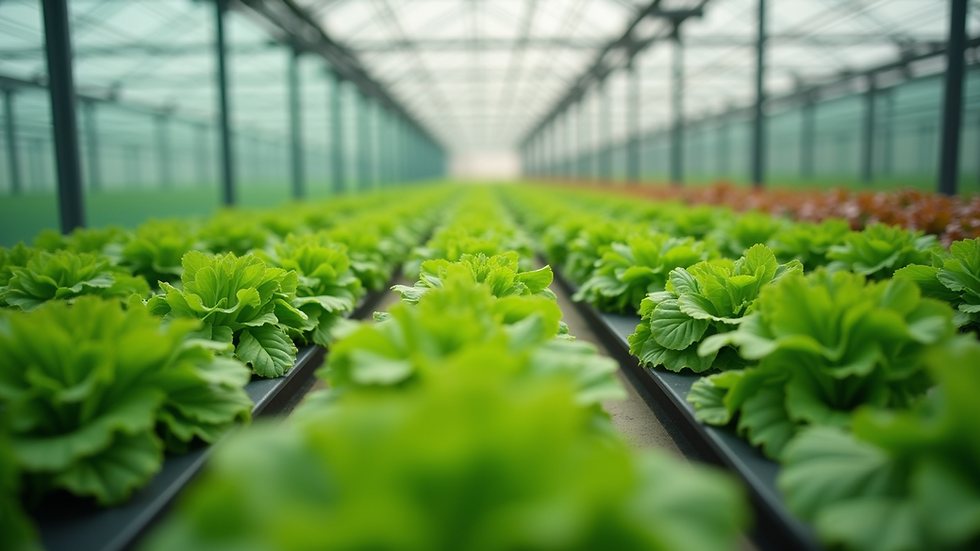Transforming Agriculture with Hydroponics
- Matthew Bowser
- Oct 13
- 4 min read
Agriculture is evolving rapidly, and one of the most exciting innovations reshaping the way we grow food is hydroponic farming. This method allows plants to grow without soil, using nutrient-rich water solutions instead. As the global population grows and arable land becomes scarcer, hydroponics offers a sustainable and efficient alternative to traditional farming. In this article, we will explore the benefits of hydroponic farming, how it works, and why it is becoming a game-changer in modern agriculture.
Understanding the Benefits of Hydroponic Farming
Hydroponic farming is a soil-less cultivation technique that uses water-based nutrient solutions to grow plants. This method offers several advantages over conventional farming, making it an attractive option for farmers and urban growers alike.
Water Efficiency: Hydroponic systems use up to 90% less water than traditional soil farming. The water is recirculated, reducing waste and conserving this precious resource.
Space Optimization: Hydroponics allows for vertical farming and dense planting, making it ideal for urban environments where space is limited.
Faster Growth: Plants grown hydroponically often mature faster because they receive optimal nutrients directly to their roots.
Reduced Pesticide Use: Controlled environments reduce the need for pesticides, resulting in cleaner and healthier produce.
Year-Round Production: Hydroponic farms can operate indoors or in greenhouses, enabling continuous crop production regardless of season.
These benefits make hydroponic farming a promising solution to meet the increasing demand for fresh, locally grown food.

How Hydroponic Systems Work
Hydroponic farming involves growing plants in a nutrient-rich water solution without soil. There are several types of hydroponic systems, each with unique features:
Nutrient Film Technique (NFT): A thin film of nutrient solution flows over the roots, providing constant access to water and nutrients.
Deep Water Culture (DWC): Plant roots are suspended in oxygenated nutrient-rich water.
Aeroponics: Roots hang in the air and are misted with nutrient solution regularly.
Drip Systems: Nutrient solution is dripped onto the base of each plant.
Ebb and Flow (Flood and Drain): The grow tray is periodically flooded with nutrient solution and then drained.
Each system is designed to maximize nutrient uptake and oxygen availability to the roots, promoting healthy and rapid plant growth.
To set up a hydroponic system, growers need:
A water reservoir
Nutrient solution tailored to the crop
Growing medium (such as coconut coir, perlite, or rockwool)
Pumps and tubing for water circulation
Grow lights if indoors
By carefully controlling these elements, hydroponic farmers can create optimal growing conditions that are difficult to achieve in soil.

What are the Advantages of Hydroponic Farming?
Hydroponic farming offers numerous advantages that address many challenges faced by traditional agriculture:
1. Higher Yields in Less Space
Hydroponic systems can produce significantly higher yields per square foot compared to soil farming. Vertical farming techniques allow growers to stack layers of crops, maximizing space usage. This is especially beneficial in urban areas where land is expensive and limited.
2. Water Conservation
Since hydroponics recycles water, it drastically reduces water consumption. This is crucial in regions facing water scarcity or drought conditions. The closed-loop systems minimize evaporation and runoff, making hydroponics a sustainable choice.
3. Reduced Use of Chemicals
The controlled environment of hydroponic farms reduces the risk of pests and diseases. This lowers the need for chemical pesticides and herbicides, resulting in cleaner produce and less environmental pollution.
4. Faster Growth and Year-Round Production
Plants grown hydroponically often mature 25-50% faster than those grown in soil. Additionally, indoor hydroponic farms can operate year-round, unaffected by weather or seasonal changes. This ensures a steady supply of fresh produce.
5. Improved Crop Quality
Hydroponic crops tend to have better flavor, texture, and nutritional content because they receive precise nutrient management. Growers can tailor nutrient solutions to optimize plant health and taste.
6. Less Labor Intensive
Automation in hydroponic systems reduces manual labor. Tasks like watering, fertilizing, and monitoring can be managed with sensors and timers, improving efficiency.
These advantages make hydroponic farming a viable and attractive option for both commercial growers and hobbyists.
Practical Tips for Starting a Hydroponic Farm
If you are considering starting a hydroponic farm, here are some practical recommendations to help you succeed:
Choose the Right System: Evaluate your space, budget, and crop preferences to select the most suitable hydroponic system.
Start Small: Begin with a small setup to learn the basics before scaling up.
Monitor Nutrient Levels: Use a pH meter and EC (electrical conductivity) meter to maintain optimal nutrient balance.
Maintain Cleanliness: Regularly clean your system to prevent algae growth and disease.
Use Quality Seeds and Nutrients: Invest in high-quality seeds and nutrient solutions for better results.
Control Environment: Manage temperature, humidity, and light to create ideal growing conditions.
Educate Yourself: Join hydroponic communities, attend workshops, and read resources to stay informed.
By following these steps, you can build a productive and sustainable hydroponic farm.
The Future of Farming with Hydroponics
Hydroponics is transforming agriculture by offering a sustainable, efficient, and scalable way to grow food. As technology advances, hydroponic farms are becoming more automated and integrated with smart systems that monitor plant health in real-time.
Urban farming initiatives are increasingly adopting hydroponics to bring fresh produce closer to consumers, reducing transportation costs and carbon footprints. Additionally, hydroponics can play a vital role in food security by enabling crop production in harsh environments such as deserts or areas with poor soil quality.
For those interested in learning more about hydroponics and its impact on modern farming, resources like hydroponics in agriculture provide valuable insights and practical advice.

Embracing hydroponic farming can help meet the growing demand for fresh, nutritious food while conserving natural resources. Whether you are a commercial grower or a home gardening enthusiast, hydroponics offers exciting opportunities to innovate and thrive in the future of agriculture.






Comments